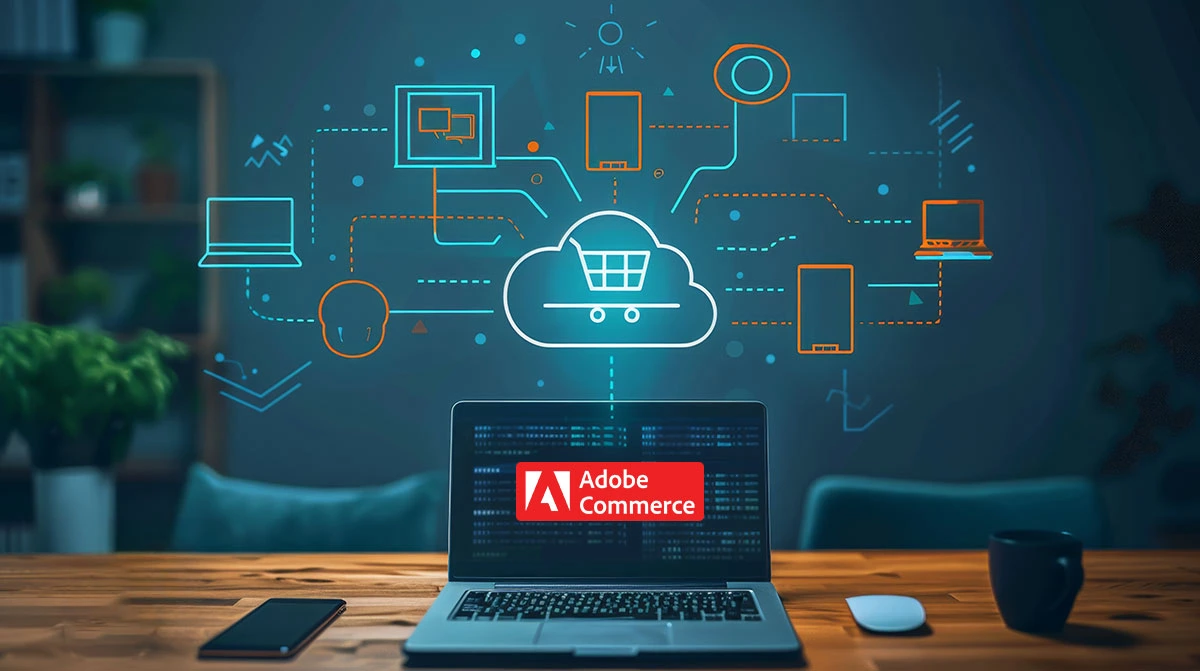The expectation for digital experiences has fundamentally changed. Customers demand instantaneous and personal service, and even a moment of friction can mean lost revenue. You can’t afford to be weighed down by slow, costly infrastructure management for your Digital Experience Platform (DXP) anymore.
That’s why Adobe Experience Manager (AEM) as a Cloud Service is so important. It’s more than just a technical migration. It’s a strategic move transforming your entire digital enterprise’s economics and operational speed. If you’re struggling with high Total Cost of Ownership (TCO), slow product launches, or escalating compliance demands, AEM Cloud offers a clear path forward.
Let’s dive into the three core pillars that drive maximum Return on Investment (ROI) for AEM in the cloud: Costs, Governance, and Release Velocity. These are the levers you control to future-proof your digital strategy.
What Exactly is AEM as a Cloud Service?
To understand the benefits, you first need to know what this platform is. Simply put, AEM as a Cloud Service is the next evolution of Adobe Experience Manager, completely rebuilt to run natively on the cloud.
It is like moving from owning a complex, temperamental factory to subscribing to a world-class, automated manufacturing service.
| Feature | Legacy AEM (On-Premise/Managed) | AEM as a Cloud Service |
| Model | Software License (Requires dedicated hosting) | True Software-as-a-Service (SaaS) |
| Updates | Manual major version upgrades (time-consuming, risky) | Always-Current (automatic, continuous updates) |
| Scaling | Vertical scaling (buy big hardware upfront) | Horizontal and Dynamic (auto-scales instantly) |
| Maintenance | Your IT team or partner manages patching/OS/DB | Fully managed by Adobe (Focus on innovation) |
It’s the shift from managing the platform to simply using the platform to innovate.
The Strategic Imperative: Why AEM Cloud is Non-Negotiable
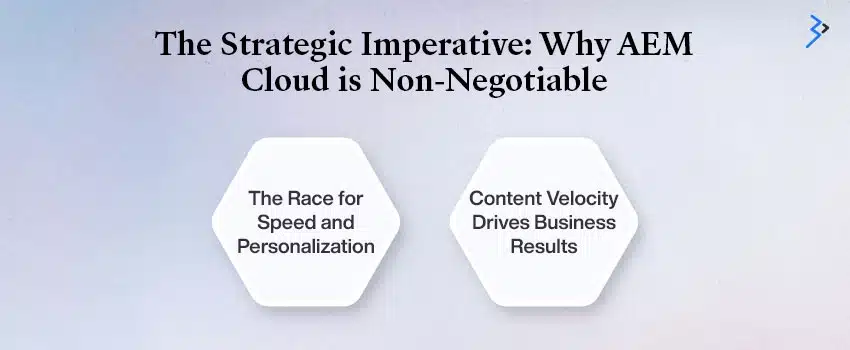
The strategic case for adopting AEM Cloud is fundamentally tied to measurable business value and risk reduction. Enterprises are no longer competing solely on product; they are competing on the experience. The platform is engineered to give you the speed and agility required in this experience-led economy.
The Race for Speed and Personalization
The digital world runs at a relentless pace. Your teams need to be able to deploy new features, launch global campaigns, and address security issues in hours, not weeks. Traditional on-premise or legacy managed services, constrained by fixed hardware and manual processes, simply can’t keep up. AEM Cloud solves this by adopting a continuous delivery model.

Content Velocity Drives Business Results
AEM Cloud drastically reduces friction in the content supply chain, delivering massive speed improvements:
| Metric | Legacy AEM (On-Premise/AMS) | AEM as a Cloud Service | Impact |
| Time to Publish Content Changes | Nearly a full week | Reduced to just hours | 75%+ decrease in cycle time. |
| Campaign Execution Time | Weeks/Months | Cut in half | Significant productivity gains for marketing. |
| Conversion Funnel Steps | Around 12 steps | Streamlined to 4 steps | Higher conversion, reduced customer attrition. |
This real-world agility means rapid time-to-market. For example, Adobe reported that a massive project like Solventum’s (3M Spin-Off) migration of 200,000 digital assets and a unified global launch was achieved in a matter of months, a timeline unimaginable on legacy systems. The focus shifts entirely from the mechanics of delivery to the strategic impact of content.
Read More – The Future of Automotive Sales – Personalized Journeys with Adobe Experience Cloud
The Cost Model: From CapEx Risk to Predictable OpEx
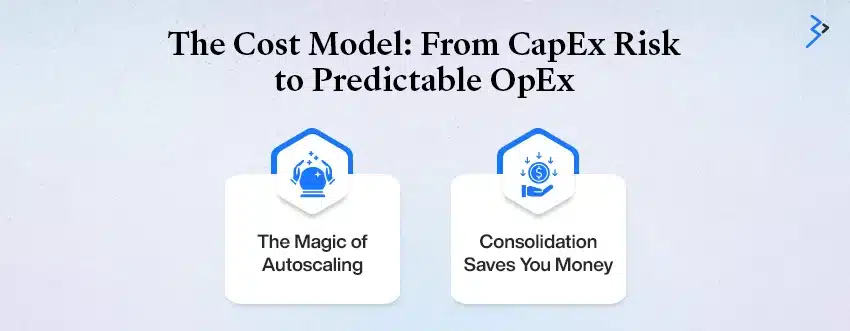
The AEM Cloud TCO story is compelling for finance leaders because it removes the biggest cost risk: unpredictable, over-provisioned infrastructure. You move your spend from expensive Capital Expenditure (CapEx) to predictable, consumption-based Operational Expenditure (OpEx).
The Magic of Autoscaling
The most profound cost advantage is dynamic resource usage. AEM Cloud is truly elastic, automatically scaling compute resources instantly based on traffic demand.
- Peak Demand Management: AEM instantly adds more capacity during big events (like holiday sales or product launches). You get zero performance degradation and no need for human intervention.
- Cost Control: When traffic is low, resources automatically scale back down. This eliminates the need to buy and maintain massive, idle hardware just to handle a few peak days a year, offering true pay-as-you-grow flexibility.
Consolidation Saves You Money
The subscription model bundles operational costs that used to be separate headaches.
| Traditional Cost Burden | AEM as a Cloud Service Model | Benefit |
| Infrastructure and Hardware | Managed by Adobe; billed as consumption (OpEx). | Eliminates CapEx risk and over-provisioning. |
| OS/Database/Security Patching | Automatic and continuous by Adobe. | Massively reduces IT labor and maintenance costs. |
| CDN and Storage | Transparently managed within the platform. | Predictable budget with no hidden costs. |
This change frees up your IT team from maintenance, helping them focus their valuable efforts on high-value, business-specific projects.
Read More – Scaling eCommerce Success with Adobe Experience Manager and Cloud Integration
Architecture and Governance: Security, Compliance, and Control
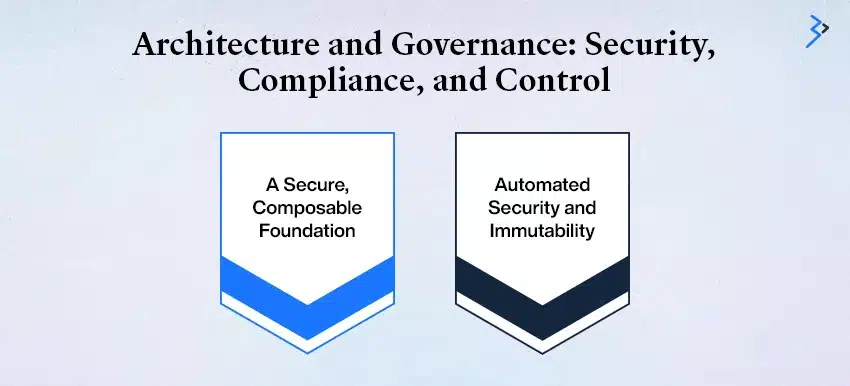
In the digital world, Strategic Governance is about maintaining security, compliance, and a clear audit trail globally. AEM Cloud embeds these capabilities into its cloud-native design.
A Secure, Composable Foundation
The architecture supports governance through a clean structure and control:
- Composable Services: The platform is decoupled into specialized services (AEM Sites, AEM Assets, AEM Forms), making the architecture cleaner, more resilient, and easier to govern through clear boundaries.
- Access Control: Security is centralized. Access is managed via the Adobe Identity Management Service (IMS), helping integrate with your corporate Single Sign-On (SSO). This is crucial for easy auditing and better compliance. This centralized governance also supports easy integration with other platforms — including WordPress Single Sign-On (SSO) to maintain secure authentication across all digital channels.
Automated Security and Immutability
Security is proactive and automated, not manual and reactive.
- Security Pipeline: The Cloud Manager CI/CD framework mandates automated vulnerability testing and code audits before deploying any code to Production. This is a critical security gate that systematically reduces risk exposure, especially vital for regulated industries.
- Immutable Code: A core principle ensures that your content is strictly separated from your code. Content authors cannot accidentally or maliciously impact the underlying application code, guaranteeing stability and providing a clean, auditable change control process.
Release Velocity: The Engine of Enterprise Agility
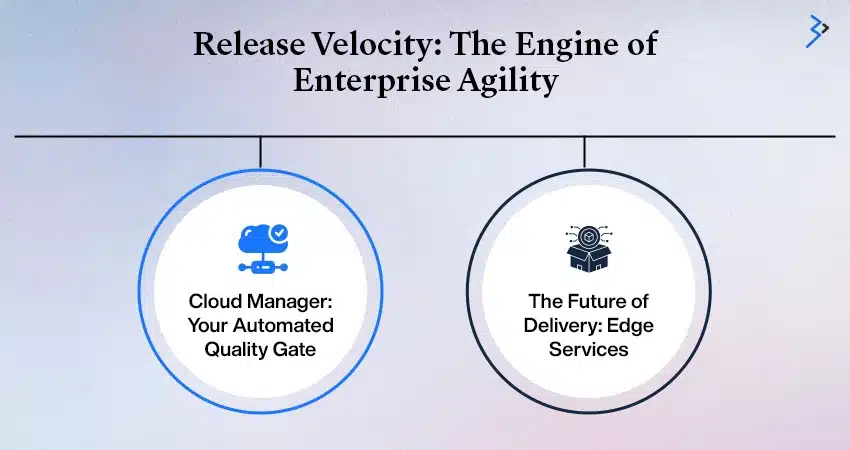
AEM Cloud turns deployment from a risky event into a predictable, continuous process using Continuous Integration/Continuous Delivery (CI/CD) via Cloud Manager.
Cloud Manager: Your Automated Quality Gate
Cloud Manager is the mandatory, automated governance framework. Every deployment must pass rigorous checks:
| Quality Gate Type | What It Checks | Business Benefit |
| Code Quality | AEM best practices and enterprise code standards. | Reduces technical debt and long-term maintenance. |
| Functional/UI | New features work as expected across devices. | Fewer bugs make it to Production. |
| Performance Audits | Page load time and overall site health (KPIs). | Ensures zero performance issues upon go-live. |
This automated, zero-downtime pipeline is why organizations achieve massive competitive acceleration. Complex, large-scale deployments that once took a year and a half are now completed in under a year.
The Future of Delivery: Edge Services
AEM’s innovation extends to content delivery with Edge Delivery Services. This serverless architecture pushes optimized content right to the network’s edge using a built-in Content Delivery Network (CDN).
- Global Speed: Decoupling delivery from the core authoring environment ensures global ultra-low latency for all customers.
- Flexible Authoring: It supports both Headful (traditional web pages) and Headless (structured content via APIs) approaches, empowering marketing teams while maintaining IT governance.
Read More – What is the Navigation in Adobe Experience Manager
Conclusion: A Foundation for Innovation
The transition to AEM as a Cloud Service is a decisive move away from managing infrastructure and towards managing innovation.
By making this strategic investment, your leadership team secures:
- Fiscal Responsibility: A predictable, consumption-based model that eliminates infrastructure waste.
- Unwavering Resilience: Automated security, unified access control, and immutable code that ensure compliance and business continuity.
- Competitive Advantage: Accelerated release velocity and zero-downtime updates that dramatically increase your time-to-market.
This is the commercial foundation for secure, scalable, next-generation digital experience management.
Partnering for Mastery
Mastering a cloud-native DXP requires deep, proven expertise in Adobe’s cloud architecture, best-in-class integration methods, and strict governance standards for Cloud Manager.
Brainvire certified consultants and developers specialize in architecting AEM Cloud solutions that prioritize modularity, performance, and seamless integration with the broader Adobe Experience Cloud. We’re here to help your organization not just migrate but truly master AEM as a Cloud Service, turning your strategic vision into realized speed and security.
Frequently Asked Questions
AEM Cloud is a true SaaS model where Adobe manages all infrastructure, maintenance, and continuous version updates (always-current). Traditional AEM required the customer or partner to manage the underlying OS, database, patching, and capacity. Cloud Service shifts focus from platform management to innovation.
Developers stop spending time on version upgrades and patching and focus purely on building new features. Content teams immediately gain access to the newest tools (like the Universal Editor) without waiting for complex IT upgrade cycles, significantly accelerating content velocity.
The platform provides transparent operational telemetry, helping you track key usage metrics (page views, API calls, storage) against your entitlements. Autoscaling is an optimization feature to prevent outages; monitoring usage helps you budget accurately and align licensing with your dynamic business needs.
Cloud Manager is the mandatory, built-in CI/CD pipeline for AEM Cloud. It enforces governance by making every code deployment pass automated quality gates (security scanning, performance testing). This process ensures all releases are vetted, there is zero downtime, and they adhere to best practices, reducing operational risk.
Yes, absolutely. AEM Cloud supports a modern hybrid CMS model. It manages both Headful content (traditional web pages) and Headless content (structured data via APIs for mobile apps, IoT, etc.), enabling a single source of truth for consistent, omnichannel experiences.
Related Articles
-
Scaling eCommerce Success with Adobe Experience Manager and Cloud Integration
These days, customers expect fast, smooth shopping experiences across every digital touchpoint—and they don’t have much patience for anything less. With competition only getting tougher, businesses need to step up
-
Why Enterprises are Moving to Adobe Commerce Cloud for Scalable eCommerce?
Summary Choosing the right platform can be the most crucial aspect of your business! Wonder why? There are nearly 26 million eCommerce websites on the Internet, indicating that your business
-
How does Adobe Real-Time CDP Empower Personalization at Scale?
Summary Did you know? A customer interacts with brands at more than six touchpoints across different channels! Yes, it’s true! Throughout their journey, customers expect a seamless and personalized experience



